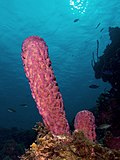 | Symbiogenesis (redirect from Endosymbiont hypothesis) distinguish organelles from endosymbionts – whole organisms living inside other organisms – by their reduced genome sizes. As an endosymbiont evolves into an organelle... 70 KB (7,468 words) - 06:05, 28 April 2024 |
 | organelle, originated some 100 million years ago from a cyanobacterial endosymbiont called UCYN-A2, which allows B. bigelowii to fix nitrogen and convert... 5 KB (430 words) - 23:38, 28 April 2024 |
 | Zooxanthellae (section Endosymbiont acquisition) genus Amphidinium, and other taxa, as yet unidentified, may have similar endosymbiont affinities. The true Zooxanthella K.brandt is a mutualist of the radiolarian... 24 KB (2,739 words) - 11:56, 24 March 2024 |
 | Trichonympha (section As an endosymbiont) Trichonympha is referred to as an endosymbiont. However, Trichonympha is also a host to bacterial symbionts. Both as an endosymbiont and as a host, Trichonympha... 29 KB (3,493 words) - 14:22, 25 April 2024 |
The proto-mitochondrion is the hypothetical ancestral bacterial endosymbiont from which all mitochondria in eukaryotes are thought to descend, after an... 5 KB (328 words) - 03:23, 30 March 2024 |
 | insects, and is in turn a host to symbiotic bacteria. The bacterial endosymbiont Ca. "Kinetoplastibacterium crithidii" maintains a permanent mutualistic... 30 KB (3,327 words) - 15:48, 12 April 2024 |
 | Sponge (section Endosymbionts) microscopic food in the water, some host photosynthesizing microorganisms as endosymbionts, and these alliances often produce more food and oxygen than they consume... 126 KB (13,138 words) - 05:08, 28 April 2024 |
 | McCutcheon JP (September 2014). "Sympatric speciation in a bacterial endosymbiont results in two genomes with the functionality of one". Cell. 158 (6):... 64 KB (6,590 words) - 15:17, 16 April 2024 |
 | Mesodinium rubrum (section The endosymbiont) autotrophic algae called cryptomonads (or cryptophytes), which contain endosymbiont red algae whose internal chloroplasts (evolved via endosymbiosis with... 9 KB (1,003 words) - 17:43, 12 April 2024 |
is a species of bacteria which was originally identified as a benign endosymbiont in plants, but has since been associated with disease in humans and cattle... 5 KB (513 words) - 03:48, 7 September 2021 |
 | Some Francisella species are pathogenic bacteria but some others are endosymbionts of ticks. Ticks do not use any other food source than vertebrate blood... 8 KB (814 words) - 01:39, 9 April 2024 |
Keeling PJ (March–April 2007). "Mitochondrial genome of a tertiary endosymbiont retains genes for electron transport proteins". The Journal of Eukaryotic... 28 KB (2,348 words) - 03:23, 19 February 2024 |
 | Bacteriocyte (section Transmission of endosymbionts) bacterial and fungal endosymbionts reside is mostly unknown. Bacteriocyte location varies depending on the insect and endosymbiont type. These cells often... 13 KB (1,514 words) - 08:35, 3 December 2023 |
 | Dyall SD, Brown MT, Johnson PJ (April 2004). "Ancient invasions: from endosymbionts to organelles". Science. 304 (5668): 253–257. Bibcode:2004Sci...304... 143 KB (15,517 words) - 23:18, 22 April 2024 |
















